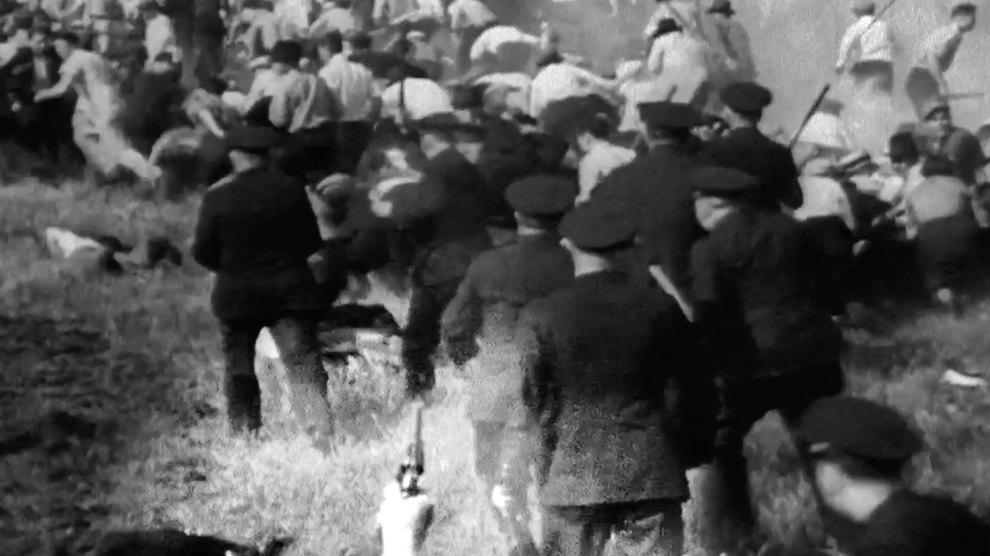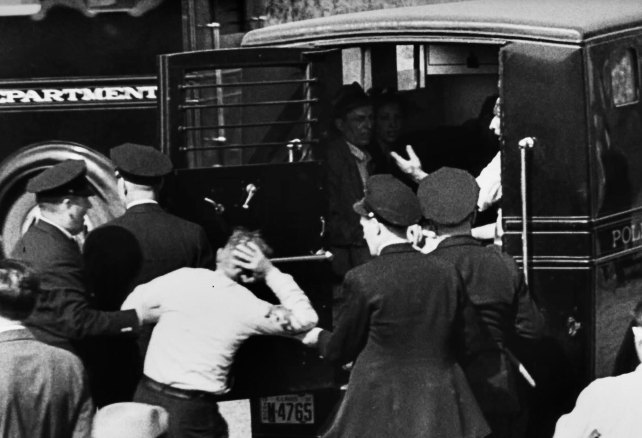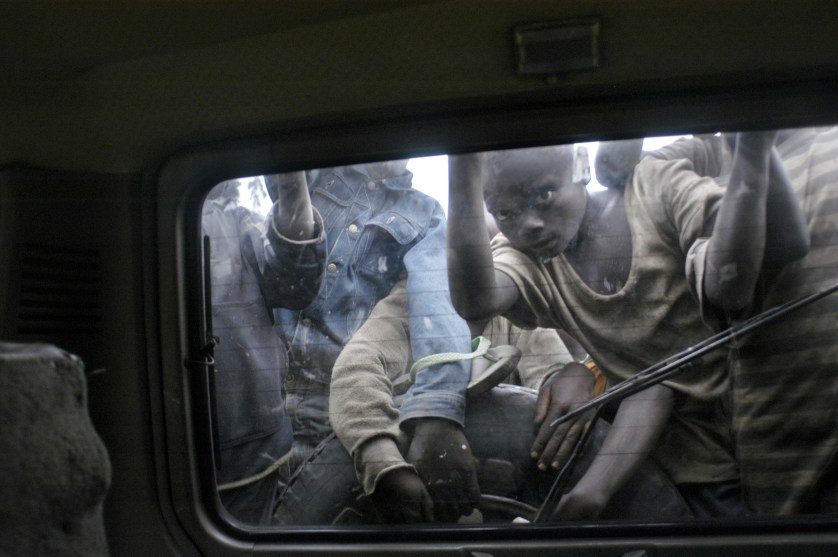
Chicago police pursue fleeing workers in this screenshot from the suppressed Paramount newsreel footage. An officer's gun can be seen in the foreground. Orlando Lippert/Paramount
Even in this age of police bodycams and bystander videos, there are certain categories of footage that most media organizations won’t share with the public. We rarely see corpses, for instance, and never executions or graphic images from school shootings. This sanitizing censorship may be intended to prevent such horrors from being normalized or gleefully distributed on the internet. But it’s hard to imagine today’s news creators suppressing, as they did in 1937, footage from the deadly anti-labor crackdown that came to be known as the Memorial Day Massacre.
On May 30, 1937, Orlando Lippert, a veteran cameraman for a leading newsreel outlet, Paramount News, was assigned to cover a Memorial Day picnic in Southeast Chicago. But his assignment would turn out to be more than just a holiday puff piece. Workers at the local Republic Steel plant had been on strike for several days, seeking recognition for their new union and vying for adoption of the same landmark concessions recently won by their colleagues at US Steel, including an eight-hour day and time-and-a-half overtime pay.
The economic hardships of the Great Depression had eased only slightly during the preceding months, and labor organizing had caught fire in many sectors. A new tactic, “sit down strikes,” helped produce major wins for labor at General Motors and Ford in nearby Detroit. Local police, friendly with the Republic Steel bosses, had already clashed with some of the strikers that week, cracking heads. And so, to demonstrate their resolve, the Steel Workers Organizing Committee sought an impressive turnout of supporters on Memorial Day.
Lippert arrived in Chicago that hot, sunny morning as men, women, and children in their Sunday best started arriving on the wide, vacant field about three blocks from the massive Republic plant. He couldn’t have guessed that he was about to witness—and document—the shootings of dozens of people by police, including at least one woman and one child, and the vast majority shot in the back or side as they fled, 10 of them fatally. Nor could he have imagined that his shocking footage, among the most sensational and meaningful of the century, would be kept from the public for weeks, until a famed investigative reporter and a crusading senator brought the images to light.
The massacre marked the first time film footage would be introduced as evidence in a congressional probe, according to reports. And it would spark the first known calls for police to carry cameras in their vans or cars—a precursor of the dashcams and bodycams that are now considered vital in exposing police malpractice.
“I made some scenes of demonstrators out in the open prairie and the police lined up across that same field,” Lippert later recalled. “When the demonstrators moved toward the east, I moved the truck east.” The picnic’s organizers had urged the crowd to march toward the plant and establish a mass (and clearly legal) picket outside the gates. Lippert captured the dramatic confrontation as the lead marchers came up against a line of 200 or more police officers—some armed with axe handles supplied by Republic, which also provided tear gas.
As angry words flew and police ordered the crowd to disperse, a few marchers tossed stones and a tree branch in the direction of the cops. Many officers, without warning, responded by drawing their pistols and firing point blank at people up front, and then at the fleeing marchers. When those officers stopped firing, their comrades pursued the crowd, clubbing people, including women, as they huddled on the ground, helpless.

A wounded marcher is escorted to a police paddy wagon.
Orlando Lippert/Paramount
Lippert captured it all on film, including the grim aftermath as police stalked the scene, refusing to provide medical care or call for ambulances, but instead arresting activists—many gravely wounded. Some were shoved or carried to paddy wagons, limp, “like sacks of potatoes,” one witness observed. Lippert stopped shooting after capturing about four minutes of footage, which he then rushed to his Paramount editors.
Studs Terkel, later a legendary local radio host and author but then a struggling actor, visited the scene the next day to perform at the union’s makeshift first aid station. He compared the massacre’s hobbling and bandaged survivors to the damaged Civil War soldiers memorably captured by photographer Matthew Brady.
Newspapers in Chicago and around the country, including the New York Times, almost uniformly swallowed the police company line: that the marchers were a “mob” rioting en route to taking over the plant—and had fired the first bullets. As for those dozens shot in the back? Probably hit by their own comrades. It was all lies. Lippert’s footage, while missing the first few seconds of the conflict while he changed lenses, showed a quite different story, with terrified men and women fleeing and falling before police bullets and clubs.
Paramount dutifully created a newsreel that included most of Lippert’s film, but then failed to distribute it to the hundreds of theaters that awaited, as I reveal in my new PBS film and book.
A Chicago citizens group led by the economist and future senator Paul Douglas made inquiries, to which a Paramount executive replied with a prepared statement: “Our pictures depict a tense and nerve-wracking episode which in certain sections of the country might very well incite…riotous demonstrations in theaters leading to further casualties. For these reasons of public policy these pictures…will stay shelved.”
It would not. A committee led by Wisconsin Sen. Robert M. La Follette, Jr., elected on the Progressive Party line, subpoenaed the footage, and one of the nation’s top investigative reporters, Paul Y. Anderson, was granted permission to view it. Anderson then wrote a series of articles for the St. Louis Post-Dispatch (reprinted by other newspapers) describing the film and interviewing some of the injured. Paramount completed a second version of its newsreel—and again failed to release it.
“We want to see that Paramount newsreel film of the Memorial Day massacre of steel-strikers by Chicago police,” wrote syndicated columnist John Franklin Carter. “We think we are sufficiently adult to sit through the spectacle of officers of the law firing on unarmed people, slugging women, shooting men in the back…We think we have a right to see that newsreel. A newsreel company covering one of the most dramatic events in the current labor war has deliberately suppressed what, from the accounts, is one of the great photographic news stories of our age.”
Dorothy Day, a journalist and co-founder of the Catholic Worker movement, wrote in her organization’s newspaper: “We are sickened by stories of brutality in Germany and Russia and Italy. And here in America…there was a public exhibition of such brutality, but the motion picture film, taken by a Paramount photographer in a sound truck, was suppressed by the company for fear that it would cause riots and mass hysteria, it was so unutterably horrible.”
LaFollette left Paramount with little choice in the matter. To cap off three days of Senate hearings that were widely covered by the press, he screened the footage himself—some of it in slow motion, then a rare technique for news film—producing gasps and tears from the audience. Paramount responded by rushing out a third version of its newsreel. Even then some theater chains refused to screen it, and officials in some cities, including Chicago and St. Louis, and the state of Massachusetts, banned any screenings of the footage. But no riots were reported.
A coroner’s jury would ultimately conclude that the 10 deaths amounted to “justified homicide.” None of the officers involved were fired or publicly disciplined. Even so, Lippert’s footage had lasting impact. The resulting shift in public opinion against police helped the steel workers eventually gain recognition and new contracts. And the official depravity Lippert exposed encouraged labor organizers and police to shy away from violent confrontations.
Indeed, no such clash to date has ever come close to producing the level of casualties suffered that day. And raw film and video now serve as indispensable tools for reporters, victims, and activists to reveal hidden truths.
Greg Mitchell wrote and directed the documentary Memorial Day Massacre: Workers Die, Film Buried, which airs on many public TV stations on Labor Day and streams at PBS.org. His companion book of the same title is the first oral history of the tragedy.















